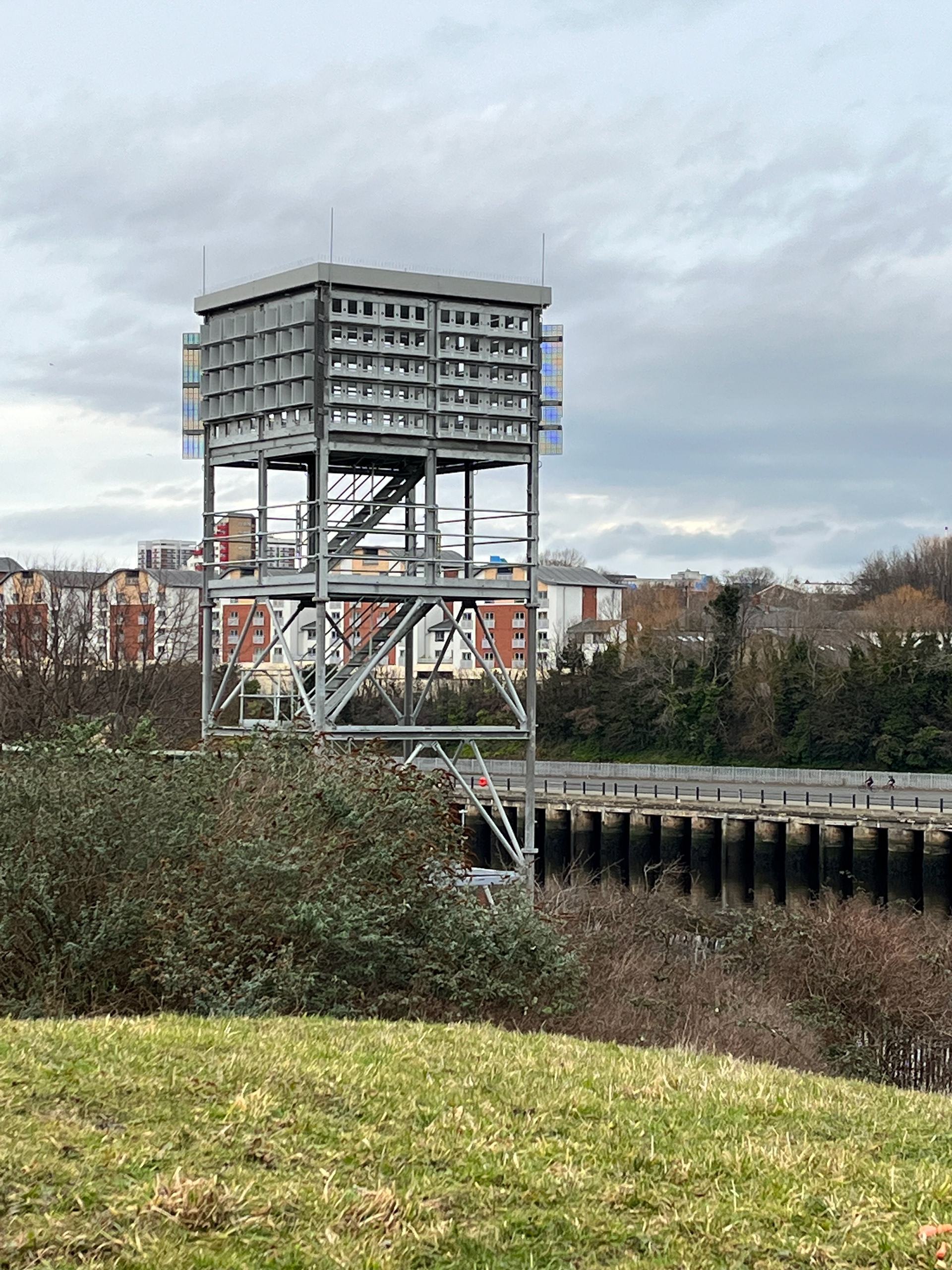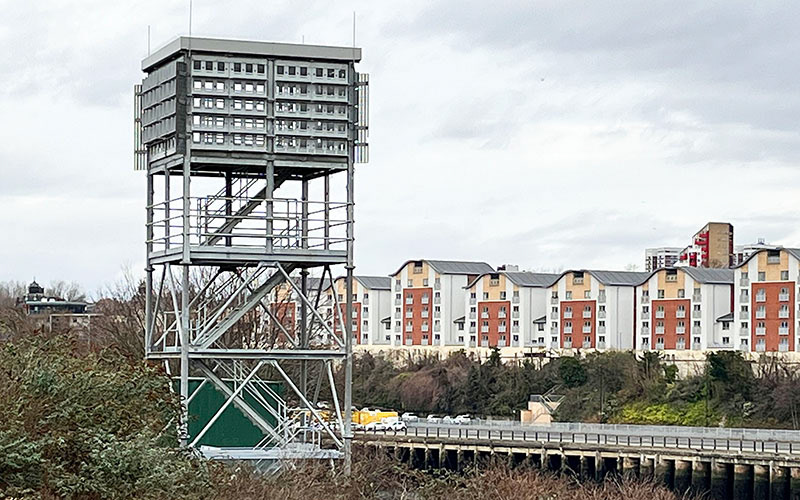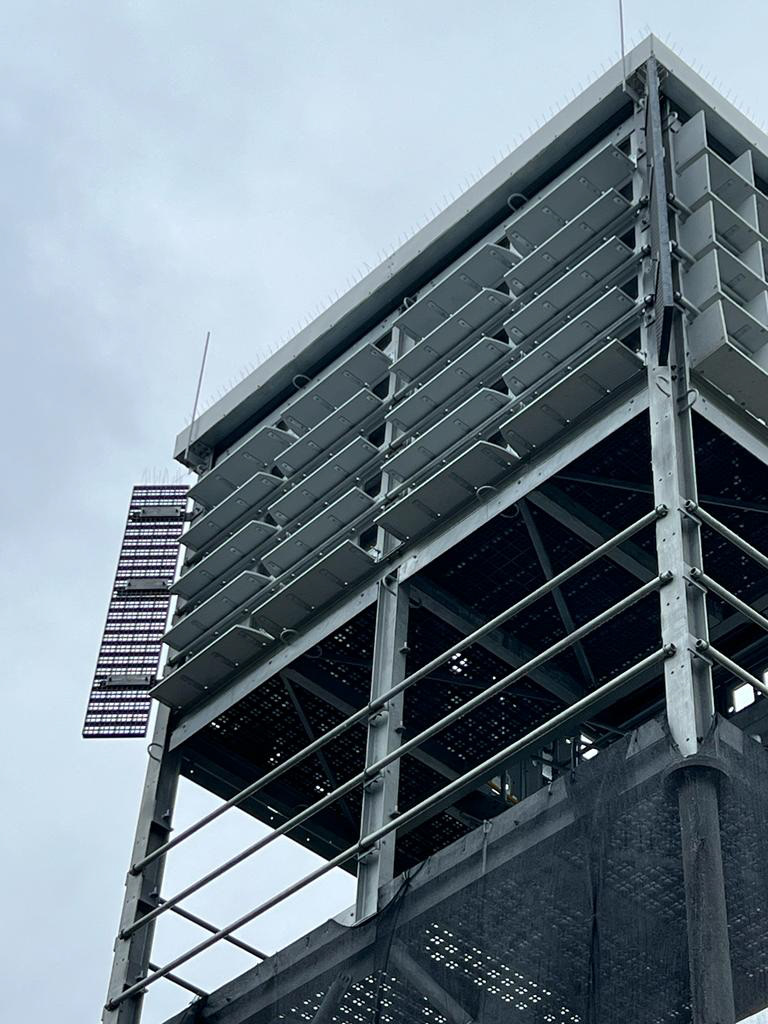







Kittiwake Nesting Tower
FLI Structures
Designed, built and installed by FLI Structures in partnership with Shoney Wind, for RWE. ‘Kittiwakery’ Installed on the River Tyne, Gateshead in February 2023. As part of the 3GW Dogger Bank South offshore wind project, a wholly owned subsidiary of RWE Renewables.
New offshore windfarms are now legally required to compensate for any impact their turbines may have on seabird populations. So nesting structures for kittiwakes, that help the birds increase their fledging success rates, are being built around our coast. Building these kittiwake nesting structures is in itself, not enough. They have to work. Then, for the windfarms to retain their consent to output power, they have to carry on working. To engage with these requirements, ongoing monitoring and supplemental feeding are used, so the nesting ledges need to be accessible without disturbing the birds and this has led to designs that are essentially buildings. Unfortunately, previously limited understanding of the bird’s needs and the microclimates around their nests; coupled with the inflexibility of these building’s designs meant that until now, they have typically failed.
FLI Structures in partnership with ecologists from Shoney Wind Ltd and kittiwake study programmes, have developed a flexible and modular galvanized steel design that delivers better performance than existing sites. The tower is tailored to different locations and allows reconfiguration until the desired breeding success is achieved. The structure mitigates against solar heat and wind related cold stress due to climate change, enabling kittwake to maintain the ideal nest microclimate required to successfully incubate eggs and protect young chicks, thus boosting populations.
To achieve the best performance and respond to changes in performance or required performance or the surrounding environment; our tower can have the layout of the nest ledges altered. Additional nesting cabins can be added. A tower can be raised, lowered, realigned or extended. An entire tower, complete with foundations can be moved to a new site and that site can be on land or offshore.
This flexibility is key to the tower delivering the kittiwake fledging success required to unlock wind farm planning consent and then enable them to continue to perform in the long term. Which means that when the world changes around them, these structures will not be abandoned, scrapped or replaced.
Galvanized steel is central to the tower’s success, not just for its practical and economic advantages but by enabling the key features that deliver the tower’s sustainability credentials.
• The modular and adaptable nature of an open, bolted, galvanized steel structure, delivers the ability to refine or radically alter the tower to ensure both the initial and ongoing performance needed to fulfil the planning consent requirements of the offshore windfarms.
• Galvanized steel screw pile and grillage foundations use no concrete. - Screw Pile foundations are 100% recyclable at end of life, unlike concrete*
- No alkaline run-off, which reduces on site pollution.
- Limited excavation and no soil cart away.
- Lighter plant required on site. * While a small percentage of concrete is recycled, it is down-cycled as low specification aggregate. Steel by contrast loses no quality via the recycling process and can be fully recycled indefinitely.
• The use of galvanized steel screw piles and a bolted, galvanized steel structure, means that when required, entire towers can be disassembled, unscrewed from the ground and moved to new sites. Saving the energy and emissions involved in the production of new structures and new foundations.
- Galvanizing delivers a major advantage over painted surfaces in these situations, with no joints stuck together or bolts full of paint.
• Appropriate levels of galvanizing give a long and predictable life in coastal environments, extending the life of the towers. Also galvanizing removes the environmental cost of painting as part of ongoing maintenance.
• All large section steel structures in the UK are already recycled at end of life. FLI’s galvanized steel kittiwake nesting tower is part of an existing circular economy.
• The kittiwake tower unlocks offshore wind consent impediments to help increase the share of renewable energy in the global energy mix and improve affordability (United Nations Sustainable Development Goal 7) and support several of the UN SD Goal 9 targets. It also strengthens the resilience and adaptive capacity of kittiwake to climate- related hazards (UN SD goal 13).
Photographs © FLI Structures
